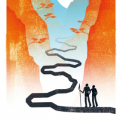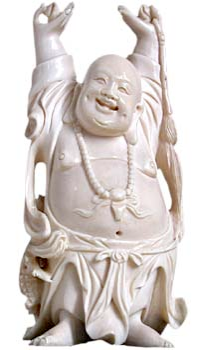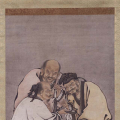Welcome home! Please contact lincoln@icrontic.com if you have any difficulty logging in or using the site. New registrations must be manually approved which may take several days. Can't log in? Try clearing your browser's cookies.
Hotei and laughter
 Jeroen
Not all those who wander are lostNetherlands Veteran
Jeroen
Not all those who wander are lostNetherlands Veteran

I have once heard it said that Hotei is the flowering of the Buddha, he is always depicted as such a jolly fellow. It is the combination of spirituality and laughter that appeals to me, the idea that being spiritual can also be joyful. Very little is actually said about it, but the statue speaks to people, and to me, which is probably why is it so popular.
https://en.wikipedia.org/wiki/Budai
Have you ever heard of laughter yoga? Groups of people get together to laugh, for a prolonged session. Going through the motions soon turns into real laughter, without comedy or joke telling. There is often much eye contact and playfulness between participants. It shakes up the energy, and has many benefits.

3




Comments
I came across this fine TED talk on the habits of happiness, by Matthieu Ricard
Friends of mine have done this three week retreat called the Osho Mystic Rose, which begins with a week of every day doing 3 hours of laughing...
I was looking for laughter meditation on google, and this came up. It seemed interesting, I’m not usually into Deepak Chopra but this 30 days of intent seems as if it might be something.
During the day there's always something to laugh about (the funny side of life/living), and I laugh a lot...
Thus have I heard....
Beware of unhappy Buddhists, they are not really practicing, just being intellectual
Monty Python rocks!
I love Hotei.
I've heard so many different stories about what the Laughing Buddha is and so I've kind of got a mishmash of what it represents in my head. I have 33 Hoteis in my shrine at the moment and one waiting to take its place in front of the Medicine Buddha when I get it.
Laughing yoga isn't for me personally. It kind of creeped me out, actually.
Yes, Hotei statues make me happy too. Although I am not a great statue collector and so don’t have any real ones, and have to content myself with pictures.
@Shoshin1 Believe it or not... Monty Python is one of those things I've saved for the future...and this is so HILARIOUS! Hahaha! I really need to watch it now
Always look on the bright side of death!
I see Hotei as like the Bodhisattva of giving. Not just gifts for children to play with but the dharma as well. Because I've heard the Laughing Buddha called Maitreya and Thich Nhat Hanh often says he thinks the next Buddha could very well be the Sangha and I picture all of us sharing our views on how we perceive the dharma as the Sangha, the Laughing Buddhas on my shrine kind of represent beings like us.
May you cause a smile or two on your way today.
I'm used to Hotei with less shiny flesh. Here is how he visits with me in my home. I had to move him from his latest haunt, the brick bench at the feet of my fireplace, in order to get better pictures. Not being a shiny marbleized creature, he's got a wee bit more control of his ecstasy, seems to me.
Joyous @Nirvana
I came across a good version of the story told about Hotei...
Anyone walking about Chinatowns in America will observe statues of a stout fellow carrying a linen sack. Chinese merchants call him Happy Chinaman or Laughing Buddha.
This Hotei lived in the T’ang dynasty. He had no desire to call himself a Zen master or to gather many disciples around him. Instead he walked the streets with a big sack into which he would put gifts of candy, fruit, or doughnuts. These he would give to children who gathered around him in play. He established a kindergarten of the streets.
Whenever he met a Zen devotee he would extend his hand and say: “Give me one penny.”
Once as he was about to play-work another Zen master happened along and inquired: “What is the significance of Zen?”
Hotei immediately plopped his sack down on the ground in silent answer.
“Then,” asked the other, “what is the actualization of Zen?”
At once the Happy Chinaman swung the sack over his shoulder and continued on his way.
I’ve been thinking about this a bit, and it seems to me as if it is about non-doing (putting the sack down) in doing (picking the sack up and carrying on). The actualisation is doing, but the significance is not-doing.